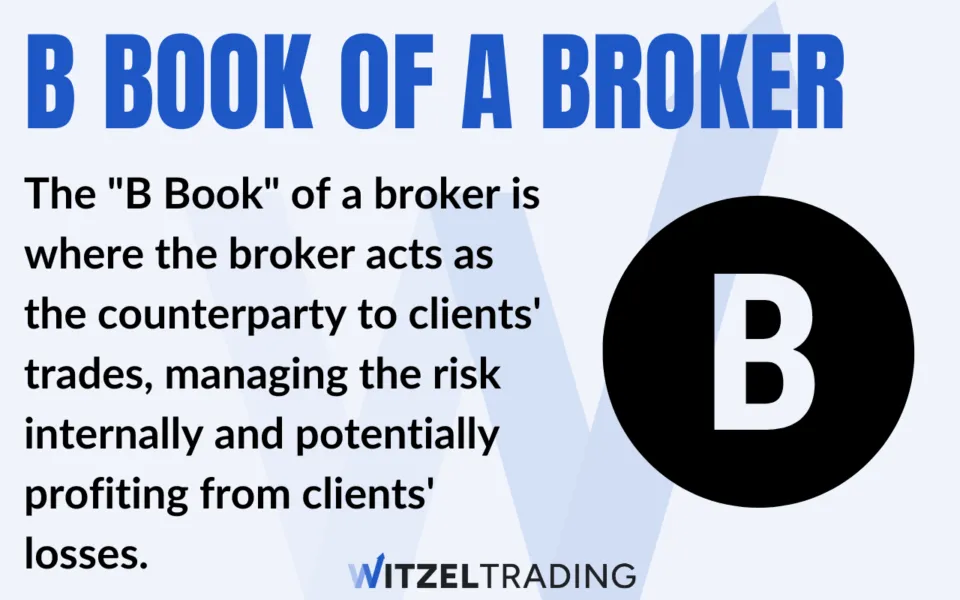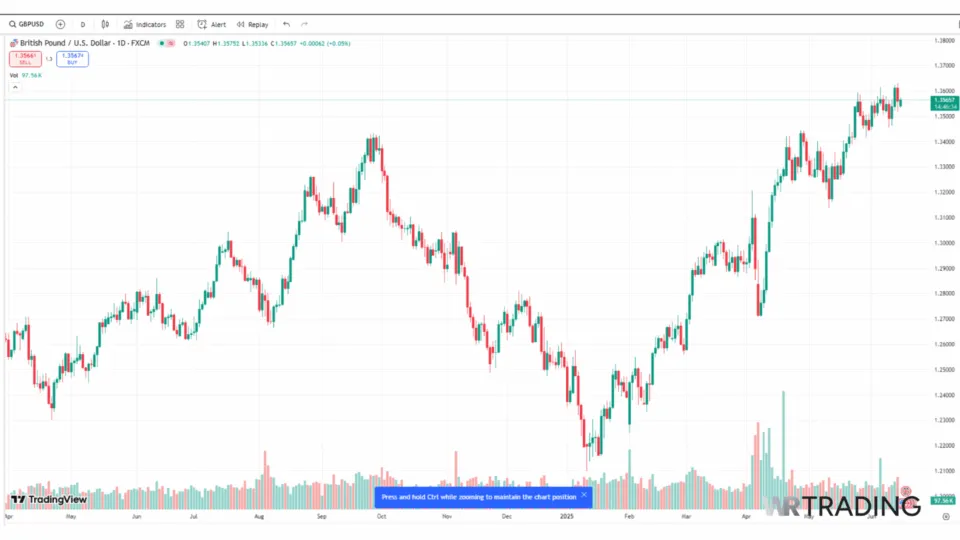A “B Book Broker” is a broker that handles trades internally instead of executing them in the open market. In short terms, the broker takes the opposite position when traders with the B book place a trade. So, if a trader profits, the broker takes a loss. In contrast, the broker profits when a trader loses. But it is not as easy as it sounds because the broker analyses the Net Exposure of its clients and then decides if it will do the B Book.
If you wonder how a broker’s B Book works, you are in the right place. At WR Trading, we’ve done our due diligence, and we’ll share its pros and cons, pricing, and other essential details so you can decide if it’s the right option for you.

Key Facts about B Book Brokers:
- Take the opposite side of their client’s trades
- B Book approach comes with significant risks
- B Book system rather than relying on external market prices
- Generally conducted under a broker license
How Does the B Book Work?
Brokers typically use the B Book model to manage trades internally rather than matching them with external parties. We realised that in a B Book model, the broker can take the opposite side of their client’s trades. However, it’s not as easy as it sounds—we will explain in more detail.
When clients buy, the broker sells to them, and when clients sell, the broker buys from them. The broker does not take all clients’ positions because of net exposure. They group all client trades together and manage overall risk by balancing them. So, while they might adjust or hedge individual trades to control risk, they aim to keep everything stable for everyone involved.
For instance, the broker can aggregate these trades into a net exposure if 10 traders take a short position of 10 lots, and another 10 traders each take a long position of 20 lots. In this case, the broker may balance the exposure by taking a B Book position of 10 lots short. This allows the broker to manage the overall risk for all clients together.
For example, suppose clients collectively decide to sell 50 units of GBP/USD at $1.30. Since the broker takes the opposite side, they buy 50 units of GBP/USD at $1.30.

The broker’s exposure is the total value of these trades. So, if each unit is worth $100,000:
- Exposure = 50 units x $100,000 = $ 5,000,000.
If the GBP/USD price rises to $1.32, clients lose, and the broker profits:
- Profit = (1.32 – 1.30) x 50 units x $100, 000 = $100, 000.
In contrast, if the GBP/USD price falls to $1.28, clients profit, and the broker incurs a loss.
- Loss = (1.30 – 1.28) x 50 units x $100, 000 = $100, 000.
In our opinion, the key aspect of this system is that the broker profits when the clients lose and loses when the clients profit. However, this doesn’t mean the broker is a swindler waiting to rob clients of their money. Brokers don’t necessarily trade with the expectation that clients will lose money.
Yet, the B Book approach comes with significant risks. If many clients win simultaneously, the broker may experience substantial losses. To reduce this risk, brokers often combine B Book with A Book strategies, hedging some trades with external liquidity providers.
Unlike the B Book model, brokers match traders with an external liquidity provider in an A Book model. The broker profits from commissions and spreads, not clients’ losses.
B-Book Pros and Cons
Pros
- Fast execution of trades under normal conditions
- Brokers may potentially make higher profits with the B Book system
- Cost-effective for brokers as they don’t have to pay fees to external liquidity providers
Cons
- Conflict of interest as fairness concerns may arise when brokers profit and clients lose.
- The broker may face significant losses if clients become better at trading
How Does the B Book Pricing Work
B Book pricing is how brokers set the prices at which they execute trades for their clients. We discovered that brokers set the prices internally in a B Book system rather than relying on external market prices. This means the prices offered to clients might differ slightly from those on the broader market.
We realised that brokers often include a spread or markup to their prices. For instance, if the market price of GBP/USD is 1.3000/1.3002 (bid/ask), the broker might offer it at 1.2998/1.3004. This markup and potential client losses in a B Book model are how brokers make money from each trade.
Based on our observation, brokers use real-time market data to set internal prices. They often track the prices from major financial markets and liquidity providers. Brokers might adjust their prices based on risk exposure. For instance, if many clients buy a particular asset, a broker might increase the cost to control their risk. Therefore, B Book pricing is crucial to how brokers manage trades and risk.
B Book Works Only With a Market Broker License
We realised that B Book operations are generally conducted under a broker license. This license allows brokers to execute trades on behalf of clients without necessarily matching them with external parties. Without this license, brokers can’t legally engage in B Book activities.
It gives brokers the authority to act as intermediaries between clients and the market. As a result, brokers can engage in different trading models and execute trades efficiently. Based on our research, the broker license is essential for brokers who want to operate under the B Book model and meet regulatory requirements.
Should You Avoid B Book Brokers?
Avoiding B Book brokers depends on your preferences, risk tolerance, and trading goals. In our observation, we realised that while working with B Book brokers comes with certain advantages, traders must weigh some factors before engaging with them. Some of these include:
Broker’s Reputation
In our opinion, researching a B Book broker’s reputation and track record is crucial before deciding to work with them. We suggest looking for other traders’ reviews, ratings, and feedback to evaluate their trustworthiness. Doing this gives traders insight into how a broker has performed.
Compliance
We recommend ensuring the B Book broker operates under a reputable regulatory framework. This protects the client’s interests and provides a trading experience. Operating under a regulatory framework allows the B Book broker to adhere to compliance standards and be held accountable for their actions. From fair pricing practices to transparent order execution, the B Book broker will be committed to protecting their clients’ interests.
Risk Tolerance
A trader must carefully assess risk tolerance before working with B Book brokers. We suggest considering factors like their investment goals, financial situation, and ability to handle market fluctuations. For example, traders with a high-risk tolerance might be comfortable with the potential risk of working with B Book brokers.
Most of the A Book Brokers also have a B Book.
Our research found that many brokers who primarily use the A Book model keep a B Book. This helps them manage risks better and potentially earn more. For example, when a trade is too risky, they can pass it to the A Book, where it gets traded in the broader market. This helps brokers handle potential losses more effectively.
We realised that market conditions affect the use of both models. For instance, brokers can switch between A Book and B Book models for the best results during high market volatility or low liquidity, allowing them to better adapt to changing market conditions.
We observed that brokers use both models primarily for profit maximisation. They can leverage both models to earn more. For example, while the B Book model lets brokers profit from clients’ losses, the A Book allows them to earn more through spreads and commissions on trades in the open market.
Therefore, most B Book brokers use the A Book model to manage risks, adapt to market conditions, and make profits.
Conclusion
While the B Book of a Broker offers advantages like quick trade execution, conflicts of interest and transparency concerns are valid possibilities. This is why at WR Trading, we recommend that traders carefully assess the risks and benefits of B Book trading before getting started. Considering risk tolerance, goals, and the broker’s reputation will help them make an informed decision. It will enable them to navigate the complexities of the B Book model and maximise its benefits. The right trading broker is essential to save costs and ensure quick order execution.
Frequently Asked Questions on B Book Brokers
Do B Book Traders Face Any Limitations If They Don’t Incorporate the A Book Model?
Yes, B Book traders encounter limitations without incorporating the A Book model. Operating solely within the B Book framework may restrict access to external liquidity, which limits trading opportunities and hinders the effectiveness of a trader’s risk management strategies.
However, integrating the A Book model allows traders to overcome these limitations, access liquidity pools, and diversify their trading strategies.
Are Any Risks Associated With Using Both the A Book and B Book Models?
Yes, combining both A Book and B Book models comes with risks. This includes exposure to external market volatility and managing diversified trading strategies. We advise that traders assess the risks involved and implement appropriate strategies to mitigate these risks effectively.
Can Traders Using B Book Brokers Access the Interbank Market Directly?
Generally, traders using B Book brokers do not have direct access to the interbank market. Instead, the B Book brokers work as counterparties to clients’ trades, executing trades internally. However, while traders cannot access the interbank market, they can still benefit from competitive pricing through their B Book brokers.
Can B Book Brokers Manipulate Prices to Benefit Their Interests?
Yes, B Book brokers can adjust prices internally. However, they must adhere to strict regulatory standards to ensure transparent pricing. This is why it’s crucial to work with reputable B Book brokers to minimise the chances of price manipulation. Moreover, when working with B Book brokers, you can monitor prices using independent sources to verify market prices.


